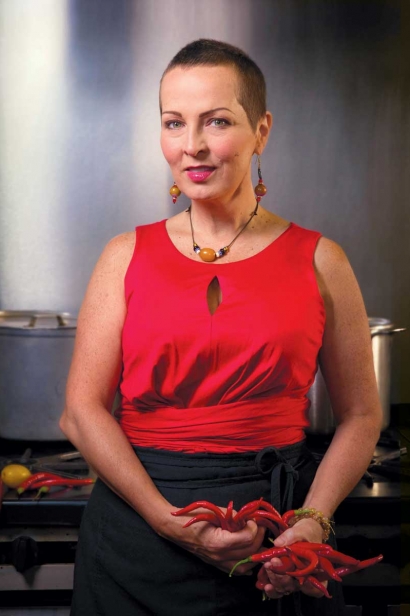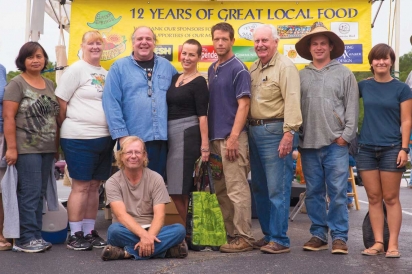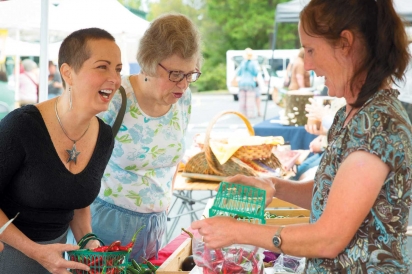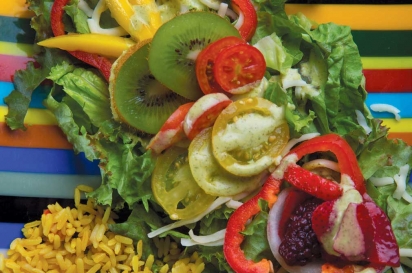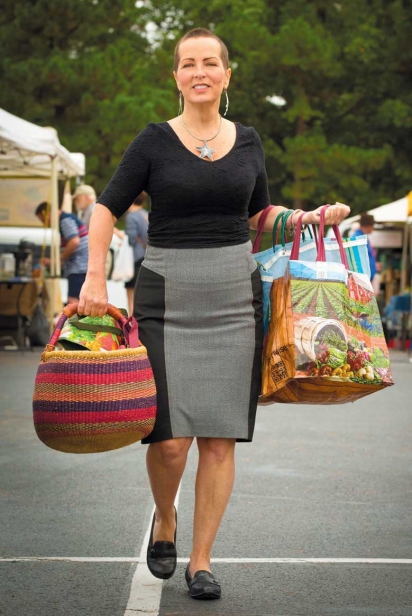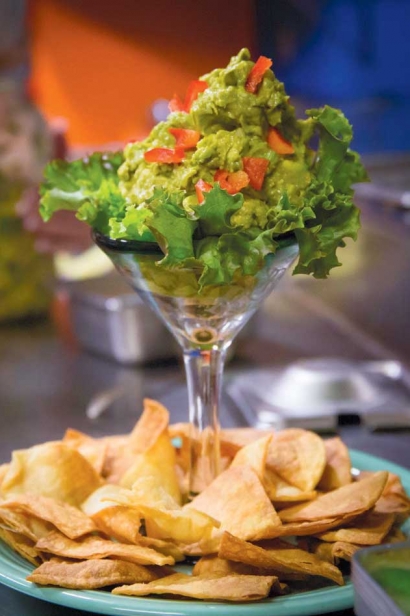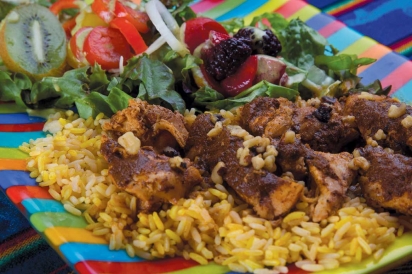Cooking, Coloring with the Seasons
Everything at KJ's Caribe Restaurante y Cantina is vibrant.
Lime green ceilings and walls painted solid red, orange, and yellow are accented by turquoise trim. Framed artwork covers the walls, and whimsical murals feature toucans, monkeys, and avocados.
Even the food served here is nothing short of a work of art.
The person behind this place is KJ Zumwalt. She is vivacious and celebrates life daily – with food, with friends, with love, and with her community in Eureka Springs.
She exudes joy, which is partly wrought from bittersweet life experiences. She chooses to be joyful and works hard, because she knows both are worthwhile.
At Caribe, she chats with customers new and old, dispenses hugs freely, and flashes her warm, wide smile to every face she sees. She is known for her generous community support, and, in August, shaved off her long, brunette locks in solidarity with Christy Davis, an employee who has cancer.
Where KJ is now evolved from her relationship with the late Clary Perez, who was her personal and business partner.
Living in New Orleans in the late 1980s, KJ sought a less crime-ridden hometown. Her mother often traveled from Little Rock to Eureka Springs, and, entranced with the place, she regularly encouraged KJ to visit.
The daughter couldn't find the town on the Rand McNally atlas, but did meet her mom there with a bad attitude in tow. She came for three days and never left. Her sister shipped her belongings.
"It was everything I was looking for," KJ says, with a focus on art, music, and culture akin to New Orleans. "There's nowhere else like Eureka. The thread that binds us to Eureka is really thick and hard to break."
KJ, who has a marketing degree, first opened a retail gift shop with her aunt. She also bartended, as she had in New Orleans, working shifts at the Crescent Hotel and elsewhere to make ends meet those first few years. In spring 1993, she landed a part-time bartending job at Center Street Grill, which quickly evolved into more hours and changed her life.
Clary had just started the business the previous fall, after spending 10 years cooking for Jack Muzio, owner of Basin Block Café, then a town mainstay.
Clary came to the United States at age 13 from Panama, after the nuns there convinced her wealthy father that a Catholic school in Alabama was best. She arrived there in 1961 in the middle of the civil rights struggle, spoke no English, and had brown skin that didn't belong to either side of that divide. She was thrown out of eateries and experienced discrimination she'd never conceived of in Panama, which had an international population.
Clary ended up with her grandmother in New York, where she was part of Stonewall and Woodstock and connected to the back-to-the-land movement. She moved to Newton County when a local woman paid women of color to help establish an intentional community there. Clary cooked for the group, and then came to Eureka Springs for work.
With a degree in education, Clary was a self-taught cook and never considered herself a chef. KJ says that Clary was a brilliant cook who could prepare any type of cuisine – from Italian to matzo ball soup.
"She just loved food, and so many people in her family never had enough money to buy enough food for their family," KJ says. Her family often had to make food for two people feed five.
"I think that's what drove her to do well and drove her to respect the food because that's when you do well with the food. You have to not only appreciate it, but you have to have a deep-seated respect."
Cooking by color
At Center Street, Clary and KJ brought something new to local palates. Customers in the 1990s hadn't heard of a chipotle pepper and needed the Spanish menu translated. Their dishes were traditional, interior Mexican and South American foods rather than the Tex-Mex border fare that was more familiar in Ozarkansas then. Everything was hand crafted, and they still hand chop all the salsas.
KJ worked the front of the house. Long before the Food Network and Bobby Flay expanded minds and palates, those first few years were largely spent educating customers. One server toted various peppers around in her apron to show diners what was in the salsas and dishes.
The business – which had dining upstairs and live music with a bar downstairs – slowly built its menu, clientele, and reputation. It struggled from financial and seasonal disasters the first three years. The next three years, they worked to climb out of that, and finally were breaking even and doing well. All along, Clary sent money to her mother in Panama each month. They also developed their recipes from 20 to 200.
Clary focused on two main aspects in the kitchen: cooking by color and attention to present at ion. KJ describes the creamy jalapeño dip ingredients – a combination of onions, garlic, jalapeños, sour cream, cilantro, salt, and tomatillos. The tomatillos matched the jalapeños' hue "when we were looking for something else for a layer of flavor." Some of their best sauces – such as mango-habanero – were derived by matching colors to layer flavors.
Their personal relationship also fueled their recipes. An early menu item that remains is the Center Street Salsa Platter – a seven-spot oyster tray that holds six salsas plus sour cream, all served with homemade flour and corn tortilla chips.
The tray resembles a painter's colorful palette. Clary created the salsa verde (with tomatillos and cilantro) to match KJ's eyes, and made its flavor red hot because KJ prefers wearing red-hot lipstick. The fresh tomato salsa blazes lipstick red. "A lot of those salsas evolved out of the relationship that we had," KJ says.
A major turning point for their business came with a glowing review in the Arkansas Democrat-Gazette. "It legitimized what we were trying to do because we weren't causal dining. We weren't tacos for $2. It was a whole different [experience] – fine dining and Latino food put together," KJ says.
In 2000, eight years into the business, Clary fell seriously ill. She was misdiagnosed repeatedly before doctors finally said it was cancer. KJ and friends still struggle with whether an earlier, correct diagnosis would have made a difference.
Clary took KJ into the kitchen, and, for about six months, they cooked together. From the 10 spices in a sauce to the perfect cooking time for fish, Clary never let her write down anything. She wanted KJ to become the kind of cook who knows intuitively what each dish requires.
KJ recalls her panic when faced with that first order ticket – chicken fajitas. "That's when I realized, I've got to get it. I've got to know what to do right now. Those people are waiting."
The colors and layers that went into the food also appeared on the plate. Lettuce was the base, topped with cheese – full of contrasts and vibrancy.
After Clary passed away in 2002, KJ stayed at Center Street for another year, even with high rent and a difficult relationship with her landlord. The business was all she had to hold on to, and she was determined not to lose it after losing Clary. Still, "every time the door opened, I expected it to be her."
For her own salvation – mental, emotional, physical, spiritual – KJ needed a fresh start.
Still the 'new place'
KJ found the space for Caribe on U.S. 62 West – what had been a longtime, woman-owned steakhouse equipped with a meat smoker. After the previous owner handed over the keys on the back porch, KJ kept on some of the employees as she started her own restaurant.
"I call this the new place, and I've been here longer than I was downtown," she says.
The flavors have evolved in the last 12 years, and even more so since KJ's partner, Sarah Niazi, joined the restaurant. Sarah brings her Persian and Afghani backgrounds to the kitchen, further enhancing flavor profiles.
"It's the evolution of falling in love," KJ says, and once again the menu is a reflection of her relationship.
For the summer menu, Sarah created a smoked duck breast drizzled with pomegranate balsamic vinegar and Persian lime extra virgin olive oil from Fresh Harvest, a local shop. A special was grilled portabella mushrooms with pesto.
KJ is a vegetarian, and she crafts her menu around that, even though it includes meat dishes. She tastes all the salsas and marinades and uses her sense of smell. She had stopped serving chicken dishes because she couldn't stand to cook the commercial product. After discovering a local farmer's organic chicken, she now has five chicken dishes on the menu.
Her pork tenderloin is based on a recipe from her aunt, but she cooks it in the smoker until it's rare and then finishes it on the grill. She likes to top it with the house mole, a sauce she concocts using more than 50 ingredients.
KJ's relationship with local farmers is instrumental to the dishes and to her success, and those farms are listed on the menu.
"I don't want to do it without them. I don't want to do it without that product. It's such a marvelous product. Once you go there, you can't really go back."
She meets with the farmers every winter and helps plan what they'll grow that upcoming season. "They grow my weird peppers; they grow my lettuce all year," she says.
Rather than being the first at the farmers market, looking for premium selections, she's among the last to go and takes the leftovers. Sometimes she gets a price break, sometimes not.
"I love to have unique, odd ingredients. I don't really care what they are, either. If nobody else has them, I probably want them. And I can do something with it. I'll figure it out. And that's the thing: I love that challenge."
KJ creates two or three menus every season, and items change regularly. It keeps her work in the kitchen interesting and challenging.
Signature dishes change with the seasons. The impressive fruit and cheese platter includes what's fresh each week at the market. The veggie fajitas that had roasted tomatoes and peppers in the summer will feature potatoes and sweet candy onions in the fall. Butternut squash, carrots, and sweet potatoes will come together in the fall vegetable soup.
Not just 'pulling it off'
Beyond the food, KJ helps sustain her community in other ways. She's on the board of the Writers' Colony at Dairy Hollow, and, at least once or twice a year, she'll host a benefit and art auction at Caribe. The whole community pitches in for these benefits, with many donating auction items, and she provides the food. The last big auction brought in $40,000 – "incredible" for a town of 2,000.
It's been calculated that, over the last 20 years, she's helped raise more than $1.2 million for people who are sick, injured, or dying, or who simply need help. These benefits started at Center Street in the 1990s, when local men were dying from AIDS.
"Even more than being a restaurant, and I think probably more importantly than being a restaurateur, I have been able and had the good fortune myself to be able to use my space and my time and my food for the benefit of others."
In 2011, she also helped organize the first Fleur Delicious Weekend, a community-wide, French-the-med celebration of the senses. Each year, she creates a special French menu with multiple courses – way outside her comfort zone. "Challenging yourself is what gets your skills going."
Though the full restaurant measures 5,000 square feet, KJ uses only a quarter of it, focusing on 51 seats in the front room and small bar rather than the total 200 seats she had previously served in the same building – yet, she yields more profit.
Since scaling down in 2008, she spends a fraction of what she once did on operating costs, needs only four employees, and generates much less food waste and stress. She also has 39 solar panels on the roof and makes compost for her herb and rose gardens.
"The best thing to happen to me was to slim down and slow down and make every plate beautiful. Because that's really what I want as a chef," she says. "I want the 50 or 75 or 100 people that come here to be really happy and to have a beautiful plate, every single one of them – even if it's a burrito."
Chef Peter Brave at Brave New Restaurant in Little Rock once told her that, when cooking for more than 50 seats, the kitchen focus becomes less about creating memorable dishes – delicious food, creatively presented – and more about what one can pull off.
"I don't want to be pulling it off. I want to do it right," she says.
RECIPE
Caribe’s Chicken Mole has earned the many kudos it has received. KJ has traveled to Mexico City twice to study “authentic” mole production, but has determined the recipe she and Clary developed in their tiny kitchen in Arkansas to be her preference. With more than 50 ingredients, the mole sauce is a complex blend of flavors – “a cross between gravy and the best barbecue sauce ever,” says KJ.
As for the local sourcing for this dish, the base of mole is roasted local tomatoes, primarily from Sycamore Bend Farm, as well as sweet candy onions from Foundation Farm, local Amish garlic, and local cilantro. The chicken is sourced from Crystal Lake Farms, so it has been raised locally on a farm that exemplifies positive animal welfare and is free of antibiotics or growth hormones.
The dish is served on Arkansas rice and paired with a Caribe Salad with a base of butterhead and red leaf lettuces and some baby beet greens, topped with tomatoes, radishes, blackberries, and sweet candy onions. These ingredients are all sourced from Foundation Farm, Sycamore Bend Farm, and Prairie Creek Farms.
The “Goddess Dressing” includes local dill from Prairie Creek Farms and cilantro from Sarah’s father’s garden.



